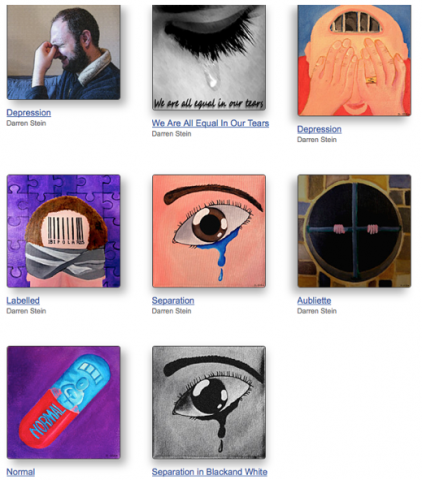This week I wanted to highlight an artist who both creates art and has been diagnosed with Bipolar Disorder. While searching the Internet I came across Darren Stein, an Australian artist and poet. Although Stein was previously diagnosed with Post-Traumatic Stress Disorder, he was more recently diagnosed with Bipolar Disorder II. He attributes eight new images he created as inspired by this new label.
Preceding the images on his website he has written, “I have been amazed at the stigma that the diagnosis has provoked among my friends, family and employer. This led me to create the images within this gallery.”

(These images can be viewed at: http://fineartamerica.com/profiles/darren-stein.html tab=artworkgalleries&artworkgalleryid=204073)
What I find appealing about these images is not their realistic quality but their crude humanistic quality. As I view these images there is a sense of honesty due to the minimal shading and flat appearance. These images do not attempt to trick the eye into believing they are round or three-dimensional. Instead, the focus of these images is on the raw emotion felt by the Stein. I think that is what makes these pieces successful.
The image I would like to focus on is the one titled “Normal” (bottom left image). I love the statement this image makes. The title alone is already hard to define—what constitutes “Normal?” It seems as if the artist is challenging the notion of the word itself. Once viewed, it is clear the image, a pill with a tiny faceless man inside, is anything but normal.
On the left side of the pill is written “Normal” as if this pill has the ability to fix every problem in a person’s life and make them ”Normal.” However, on the right side of the pill we see the true statement of the piece; an alien-looking form in a straight jacket. “Normal” is then depicted as a jail for the artist. The pill is just another item separating him from others and his own mind. Stein describes the image as a depiction of “anti-depressant medication… it demonstrates the effect of restraining the patient’s mind with a medical straight-jacket.” The bright blue used in this part of the pill gives it an extremely eerie quality. Almost as if while looking at a pill that is what Stein sees staring back at him. As the viewer I can now see what he sees. This piece leaves me thinking–what is the consequence of taking medication to “fix” a problem? Did it leave Stein feeling more or less normal?
What is normal?

